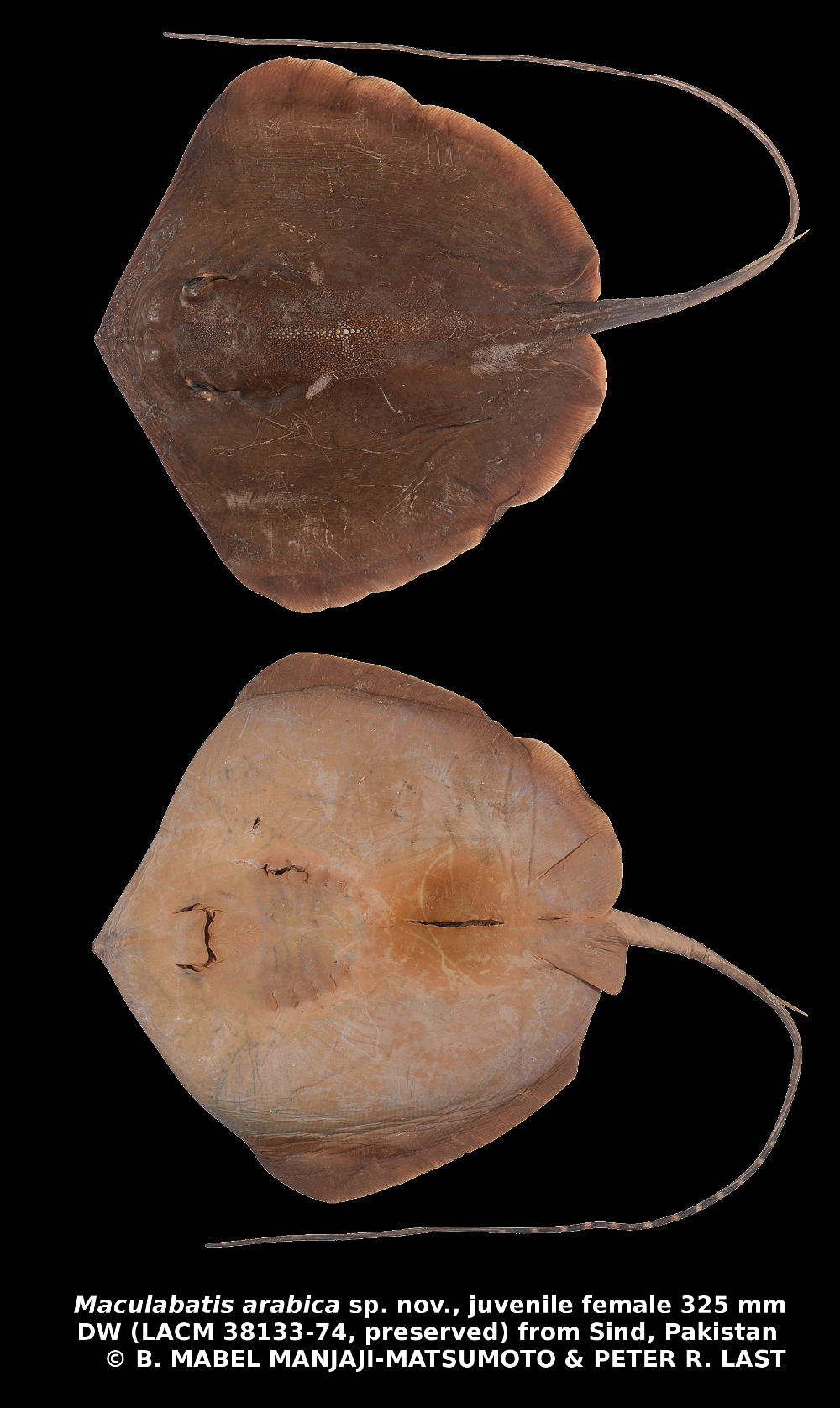Maculabatis arabica
Manjaji-Matsumoto & Last, 2016
Arabic whipray
Classification: Elasmobranchii Myliobatiformes Dasyatidae
Reference of the original description
Two new whiprays, Maculabatis arabica sp. nov. and M. bineeshi sp. nov. (Myliobatiformes: Dasyatidae), from the northern Indian Ocean. Zootaxa, 4144(3), 335–353
Two new whiprays, Maculabatis arabica sp. nov. and M. bineeshi sp. nov. (Myliobatiformes: Dasyatidae), from the northern Indian Ocean. Zootaxa, 4144(3), 335–353
Types
Maculabatis arabica
Holotype: LACM: 38133-74; Paratype: BPBM: 27511; CSIRO: H 7997-01 (formerly part of LACM 38318-11); LACM: 38311-34; LACM: 38312-27; LACM: 38318-11; USNM: 216232; USNM: 216235; USNM: 216238; USNM: 216239; USNM: 216246; USNM: 216247; USNM: 216248;
Maculabatis arabica
Holotype: LACM: 38133-74; Paratype: BPBM: 27511; CSIRO: H 7997-01 (formerly part of LACM 38318-11); LACM: 38311-34; LACM: 38312-27; LACM: 38318-11; USNM: 216232; USNM: 216235; USNM: 216238; USNM: 216239; USNM: 216246; USNM: 216247; USNM: 216248;
Description :
Citation: Maculabatis arabica Manjaji-Matsumoto & Last, 2016: In: Database of modern sharks, rays and chimaeras, www.shark-references.com, World Wide Web electronic publication, Version 12/2025
Please send your images of "Maculabatis arabica" to info@shark-references.com

Holotype of Maculabatis arabica sp. nov, juvenile female 325 mm DW (LACM 38133-74, preserved) from Sind, Pakistan © B. MABEL Manjaji-Matsumoto & PETER R. LAST

Holotype of Maculabatis arabica sp. nov, juvenile female 325 mm DW (LACM 38133-74, preserved) from Sind, Pakistan © B. MABEL Manjaji-Matsumoto & PETER R. LAST
Common names
 Arabic whipray
Arabic whipray
 Arabic whipray
Arabic whipray
Short Description
Original diagnosis after MANJAJI-MATSUMOTO & LAST, 2016 [24334]: A species of Maculabatis (to at least 63 cm DW) distinguished by a combination of the following characters: disc broadly rhomboidal, length 89–93% DW; snout moderately elongate with small apical lobe, snout angle 113–121°; pectoral-fin apices narrowly rounded; orbits small, protruding slightly; mouth relatively narrow, width 1.1–1.6 in internasal width; distance between first gill slits 2.1–2.3 times internasal distance; distance between fifth gill slits 1.4–1.5 times internasal distance, 28–30% of ventral head length; pelvic-fin base narrow, 12–13% DW; small yellow, seed-shaped suprascapular denticle followed by a slightly larger white, heart-shaped denticle; weak primary denticle band present in young but soon becoming inconspicuous; secondary denticle band irregularly suboval, relatively narrow with well-defined lateral margins, rounded forward of orbit and not extending lateral to orbit even in large adults; band broad near tail base in adults; dorsal disc uniformly brownish (lacking white spots); ventral disc pale with broad, weakly-defined and slightly darker margins; anterior tail lightbrown on dorsal surface and usually without white lateral spots; tail banded dorsally behind caudal-sting base, bands more obscure or absent with age; pectoral-fin radials 127–135; total vertebral count, including synarcual centra 102–111, monospondylous centra 41–47, pre-sting diplospondylous centra 55–68.
Original diagnosis after MANJAJI-MATSUMOTO & LAST, 2016 [24334]: A species of Maculabatis (to at least 63 cm DW) distinguished by a combination of the following characters: disc broadly rhomboidal, length 89–93% DW; snout moderately elongate with small apical lobe, snout angle 113–121°; pectoral-fin apices narrowly rounded; orbits small, protruding slightly; mouth relatively narrow, width 1.1–1.6 in internasal width; distance between first gill slits 2.1–2.3 times internasal distance; distance between fifth gill slits 1.4–1.5 times internasal distance, 28–30% of ventral head length; pelvic-fin base narrow, 12–13% DW; small yellow, seed-shaped suprascapular denticle followed by a slightly larger white, heart-shaped denticle; weak primary denticle band present in young but soon becoming inconspicuous; secondary denticle band irregularly suboval, relatively narrow with well-defined lateral margins, rounded forward of orbit and not extending lateral to orbit even in large adults; band broad near tail base in adults; dorsal disc uniformly brownish (lacking white spots); ventral disc pale with broad, weakly-defined and slightly darker margins; anterior tail lightbrown on dorsal surface and usually without white lateral spots; tail banded dorsally behind caudal-sting base, bands more obscure or absent with age; pectoral-fin radials 127–135; total vertebral count, including synarcual centra 102–111, monospondylous centra 41–47, pre-sting diplospondylous centra 55–68.
Distribution
Arabian Sea, off Pakistan (Sonmiani Bay, Baluchistan and west of Turshian Creek, Sind) and eastward to nearby Gujarat Province, India [24334] Source: www.gbif.org
Arabian Sea, off Pakistan (Sonmiani Bay, Baluchistan and west of Turshian Creek, Sind) and eastward to nearby Gujarat Province, India [24334] Source: www.gbif.org
Dentition
Teeth small, subequal in size in upper and lower jaws; cone-shaped with blunt peaks and prominent horizontal groove. [24334]
Teeth small, subequal in size in upper and lower jaws; cone-shaped with blunt peaks and prominent horizontal groove. [24334]
Remarks
shark-references Species-ID=14665;
shark-references Species-ID=14665;
Parasites (arranged by Jürgen Pollerspöck)
Cestoda
Cestoda
- Rhinebothrium atabaki Golzarianpour, Malek, Golestaninasab, Sarafrazi & Kochmann, 2021 [29351]
- Rhinebothrium gossi Omrani, Golzarianpour, Malek, Golestaninasab & Seiedy, 2025 [34316]
- Rhinebothrium palmeri Omrani, Golzarianpour, Malek, Golestaninasab & Seiedy, 2025 [34316]

















